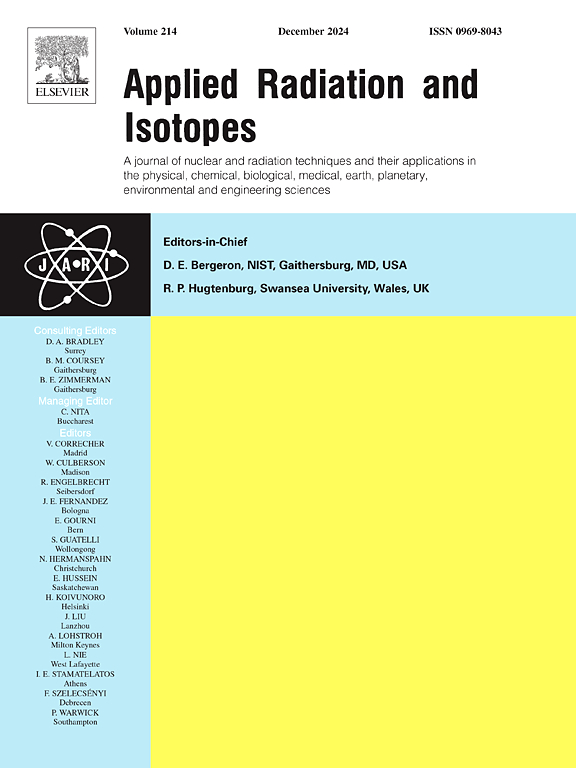Study of the gamma radiation fields of irradiators in a calibration laboratory using Monte Carlo codes
IF 1.6
3区 工程技术
Q3 CHEMISTRY, INORGANIC & NUCLEAR
引用次数: 0
Abstract
The Laboratório de Calibração de Dosímetros (LCD), a dosimeter calibration laboratory of the Centro de Desenvolvimento da Tecnologia Nuclear (CDTN), acquired a new gamma irradiator, the Hopewell Designs model G10, with a source with a nominal activity of 1.85 TBq. To employ the new irradiator in the LCD, it is necessary to characterize its gamma radiation field. This work aims to study the gamma radiation field around the new LCD/CDTN irradiator, using Monte Carlo computational codes MCNP and PHITS. The laboratory and the new (Hopewell G10) and old (STS OB85) irradiators were modeled. The air kerma and ambient dose equivalent rates were determined for various irradiation scenarios, from a simple free point-like source in air, to a more complex model, considering both irradiators in the irradiation rooms of the laboratory. Radiation levels in areas adjacent to those rooms were also assessed, for radioprotection purposes. Air kerma rate, , and ambient dose equivalent rate, , constants were also calculated and compared with values available in the literature. Experimental measurements were made with calibrated ionization chambers to validate the results obtained through the simulations. The less complex simulations were useful to validate the methodology and to assess the influence of scattered radiation. Comparisons were made between the results obtained using the PHITS and MCNP codes. Simulation results obtained in various points inside the irradiation rooms agreed well with the experimental measurements (within 1.84 % when using the MCNP code). Simulations carried out in areas adjacent to the irradiation rooms presented higher discrepancies compared to measured values. In those cases, variance reduction techniques must be used to improve the agreement with the experimental measurements. However, the simulated models can be used in dosimetric studies performed inside the irradiation rooms.
用蒙特卡罗代码研究校准实验室辐照器的伽马辐射场
核能技术研究中心(CDTN)的一个剂量计校准实验室Laboratório de calibra ode Dosímetros (LCD)获得了一个新的伽马辐照器,Hopewell Designs G10型,其标称活度为1.85 TBq。为了在液晶显示器中应用这种新型辐照体,有必要对其伽马辐射场进行表征。本文利用蒙特卡罗计算代码MCNP和PHITS对新型LCD/CDTN辐照体周围的伽马辐射场进行了研究。实验室和新的(Hopewell G10)和旧的(STS OB85)辐射器进行了建模。考虑到实验室辐照室内的两种辐照器,从空气中简单的自由点状源到更复杂的模型,确定了各种辐照情景下的空气当量和环境剂量当量率。为了辐射防护目的,还评估了这些房间附近地区的辐射水平。还计算了空气克尔玛率ΓδKa和环境剂量当量率ΓδH *(10)常数,并与文献中提供的值进行了比较。用标定的电离室进行了实验测量,验证了模拟所得的结果。较不复杂的模拟有助于验证方法和评估散射辐射的影响。比较了使用PHITS和MCNP代码获得的结果。在辐照室内各点的模拟结果与实验测量结果吻合较好(使用MCNP代码时在1.84%以内)。与测量值相比,在辐照室附近区域进行的模拟显示出更大的差异。在这些情况下,必须使用方差减少技术来提高与实验测量的一致性。然而,模拟模型可用于在辐照室内进行的剂量学研究。
本文章由计算机程序翻译,如有差异,请以英文原文为准。
求助全文
约1分钟内获得全文
求助全文
来源期刊

Applied Radiation and Isotopes
工程技术-核科学技术
CiteScore
3.00
自引率
12.50%
发文量
406
审稿时长
13.5 months
期刊介绍:
Applied Radiation and Isotopes provides a high quality medium for the publication of substantial, original and scientific and technological papers on the development and peaceful application of nuclear, radiation and radionuclide techniques in chemistry, physics, biochemistry, biology, medicine, security, engineering and in the earth, planetary and environmental sciences, all including dosimetry. Nuclear techniques are defined in the broadest sense and both experimental and theoretical papers are welcome. They include the development and use of α- and β-particles, X-rays and γ-rays, neutrons and other nuclear particles and radiations from all sources, including radionuclides, synchrotron sources, cyclotrons and reactors and from the natural environment.
The journal aims to publish papers with significance to an international audience, containing substantial novelty and scientific impact. The Editors reserve the rights to reject, with or without external review, papers that do not meet these criteria.
Papers dealing with radiation processing, i.e., where radiation is used to bring about a biological, chemical or physical change in a material, should be directed to our sister journal Radiation Physics and Chemistry.
 求助内容:
求助内容: 应助结果提醒方式:
应助结果提醒方式:


